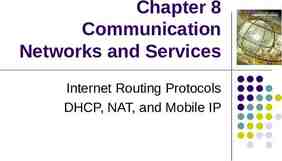The NOAA Operational High-Resolution CrIS Channel Selection: Impacts
16 Slides5.10 MB
The NOAA Operational High-Resolution CrIS Channel Selection: Impacts On NUCAPS Retrievals Jonathan W. Smith1 Antonia Gambacorta1, Chris Barnet1, Nadia Smith1, Brad Pierce2, Walter Wolf2, Tom King2, Mitch Goldberg3 NASA Sounder Science Team Fall Meeting Wednesday, September 14, 2016 1 Science and Technology Corporation 2 NOAA/NESDIS STAR 3 NOAA JPSS Program
Introduction The Cross-Track Infrared Sounder (CrIS) is a Fourier spectrometer covering the longwave (655-1095 cm-1, “LW”), midwave (1210-1750 cm-1, “MW”), and shortwave (2155-2550 cm-1, “SW”) infrared spectral regions. NUCAPS Phase I, II, and III operations: – – – NUCAPS Phase IV operations: – – – Maximum geometrical path difference L 0.8 cm (LW), 0.4 cm (MW) and 0.2 cm (SW) Nyquist spectral sampling (1/2L): 0.625 cm-1, 1.25 cm-1 and 2.5 cm-1 Total number of channels: 1305 Maximum geometrical path difference L 0.8 cm in all three bands Nyquist spectral sampling (1/2L): 0.625 cm-1 in all three bands Total number of channels: 2211 12 guard channels Motivation for a channel selection: – Assimilation of full radiance spectra is not computationally efficient for near real time data processing. A channel selection is required to expedite both data assimilation and retrieval processes. Attention must be paid to minimizing the loss of information content such that the final retrieval quality is not deteriorated 2
Channel Selection Methods: Two Schools of Thought Jacobians or Physical method is a physically-based methodology where channels are selected upon their spectral properties. For each atmospheric species, we perform a spectral sensitivity analysis and retain the spectrally purest channels. Other than spectral purity, priority is given to vertical sensitivity properties, instrumental noise and RTA errors. Suited for sequential steps retrieval methodologies, works also for simultaneous optimal estimation retrieval techniques. Details to be explained ahead. Rodgers method follows a statistical iterative approach where channels are incrementally added after being tested against an increase in degree of freedom. This methodology is suited for simultaneous optimal estimation retrieval techniques. Both methods: a constant channel selection is normally used, which is derived as an average from multiple optimal selections computed over different geophysical regimes (polar, mid latitudes, tropical, land, ocean, desert).
Why do we use the Jacobians method? NUCAPS required all sky operational products: – Cloud cleared radiances – Cloud top pressure and fraction – Surface temperature – Vertical temperature – Water vapor – Trace gases: O3, CH4, CO, CO2, SO2, N2O, HNO3 Future candidates: – NH3 (Ammonia), HCO2H (Formic Acid), CH3COOONO2 (“PAN”) Most channels are largely contaminated by clouds, temperature and water vapor signals. A “trace gas” is a gas which makes up less than 1% of the volume of the Earth’s atmosphere. Trace gas radiative signals are in the range of the instrument noise. Answer: Spectral purity combined with a sequential retrieval approach is essential for the retrieval of the full list of NUCAPS products, particularly for trace gases, under all sky conditions. In depth description available in: A.Gambacorta and C.Barnet, Methodology and information content of the NOAA NESDIS operational channel selection for the Cross-Track Infrared Sounder (CrIS), IEEE Transaction on geoscience and remote sensing. Vol. 51, No. 6, 2013. DOI: 10.1109/TGRS.2012.2220369 4
Spectral Purity Analysis (band 1) SST 1K T 1K H2O 10% O3 10% CH4 2% CO 1% Perturbation Applied Brightness temperature difference ( ΔBT ) terms represent the sensitivity of each channel to a given perturbation species and are indicative of the degree of “spectral purity” of each channel. Perturb these gases (left column) by that amount or percentage (right column), you obtain a perturbation (ΔBT) in brightness temperature (figure above). The magnitude of ΔBT describes how sensitive a channel is to the perturbed species. You select those channels that tend to be sensitive to only your species of interest with minimum interference from the other species. You still account for the residual interference as an error term in the retrieval measurement error covariance. 5
Temperature Sounding Channels Use channels that are sensitive to well mixed and slowly varying gases, such as carbon dioxide. Vertically, we select multiple channels whose sensitivity functions peak at different altitudes. Temperature Sensitivity Functions – channels with sharpest sensitivity functions are preferred. Based on Kaplan et al. results: – Along the absorption wings of the 15 μm region (main interfering sources: water vapor and ozone) – In the band head of 4.3 μm region (Caveat: non –LTE [2225-2390 cm-1] and solar reflectivity occurring during daily conditions.) Channels can still be used if properly taken into account in the RTA). Include all channels in the 2380-2400 cm-1 region because good signal to noise Globally optimal – viewed high-latitude, midlatitude, and tropical cases Current temperature sounding channel selection 6
Surface Temperature and Cloud Channels Surface Temperature and Emissivity Channels Window channels (high transmittance from all species) have been selected in the 750 cm-1 – 1100 cm-1 and 2150 cm-1 -2540 cm-1 window regions Caveat: avoid channels sensitive to desert emissivity (1000 cm-1 to 1275 cm-1) if not properly taken into account in the RTA. Cloud sensitive channels Subset (most pristine) of the temperature channels Cover all vertical layers of troposphere Cloud height is a subset of cloud clearing channels where shortwave channels are removed 7
Atmospheric Constituents Channels (water vapor and trace gases) Tropics 6 S To ensure the highest signal to noise, preferentially core spectral line channels of atmospheric constituents have been selected Both core and wings are useful to sense the full vertical column Careful attention to the interference of other absorbing gases. Water vapor sensitivity peaks are slightly lower in altitude due to the a lower altitude tropopause in the mid-latitudes Globally optimal Mid-latitude 26 S 8
CO channel selection for Ft. McMurray, Alberta fire case The selection was made on multiple geophysical regimes (polar, midlatitude, tropics, and fire) to ensure globally optimal examine polluted vs relatively clear regimes. Testing CO selection over focus areas to ensure global optimality and to serve users needs
Fire Case Study Ft. McMurray . . 1 May 2016 NUCAPS retrieval over North America Highlighting the Ft. McMurray, Alberta Fire Pressure level: 496.62 hPa 120 ppbv over fire
Channel Selection EDR #chns T 54 TSurf 27 H 2O 88 O3 31 CO 22 CH4 38 CO2 39 Total 299
Total Variance Explained Gambacorta and Barnet, IEEE, 2013 Low– resolution CrIS channel subset explains 99.99% of full channel list Improvement in the explained variance resulting in the incremental addition of the remaining trace gas sensitive channels 62 H2O Total variance Explained (%) 87 T 24 window 53 O3 54 CH4 53 CO2 27 CO 28 HNO3 24 N2O 24 SO2 Will repeat this process for this high-resolution channel selection Expect the subset of channels to reconstruct the full spectrum, hence no information content loss occurs due to thinning of radiance. Avoid discontinuity in data assimilation 12
CrIS Channel Selection for Operational Users NOAA AIRS channel selection operational users – NCEP/JCSDA, GMAO, NRL/AFWA, ECMWF, UK Met Office, Meteo France, DWD, CMC, JMA, ABM, EUMETSAT and all 23 European member states. NOAA IASI channel selection operational users – NCEP/JCSDA, GMAO, NRL/AFWA, CMC. NOAA CrIS channel selection operational users – Will have the same operational user outreach of the AIRS channel selection – With the addition of the full WMO/ GTS user network 13
NUCAPS High Res Trace Gas Product Evaluation Initiative is based on 2 recently funded JPSS proposals. 1. Greg Frost: “Understanding emissions and tropospheric chemistry using NUCAPS and VIIRS” 2. Brad Pierce: “High Resolution Trajectory-Based Smoke Forecasts using VIIRS Aerosol Optical Depth and NUCAPS Carbon Monoxide Retrievals “ NUCAPS (and AOD f/ VIIRS) will be used within IDEA (Infusing Satellite Data into Envir. AQ Applications) http://www.star.nesdis.noaa.gov/smcd/spb/aq/ 14
Future Work: Maintenance and Optimization Re-optimize and deliver the channel selection once the latest version of the RTA is delivered Re-optimize to include channel selection for N 2O, SO2, HNO3 Reconstruct the high-resolution to ensure no information content loss Keep low-resolution temperature and water vapor channels in the namelist with the high-resolution channels in order to avoid discontinuity Continue to run NUCAPS various global cases Compare NUCAPS to ECMWF truth for temperature and water vapor Complete a channel selection for IASI Continue to ensure that users obtain the best products
Acknowledgements Larabee Strow Lihang Zhou





















